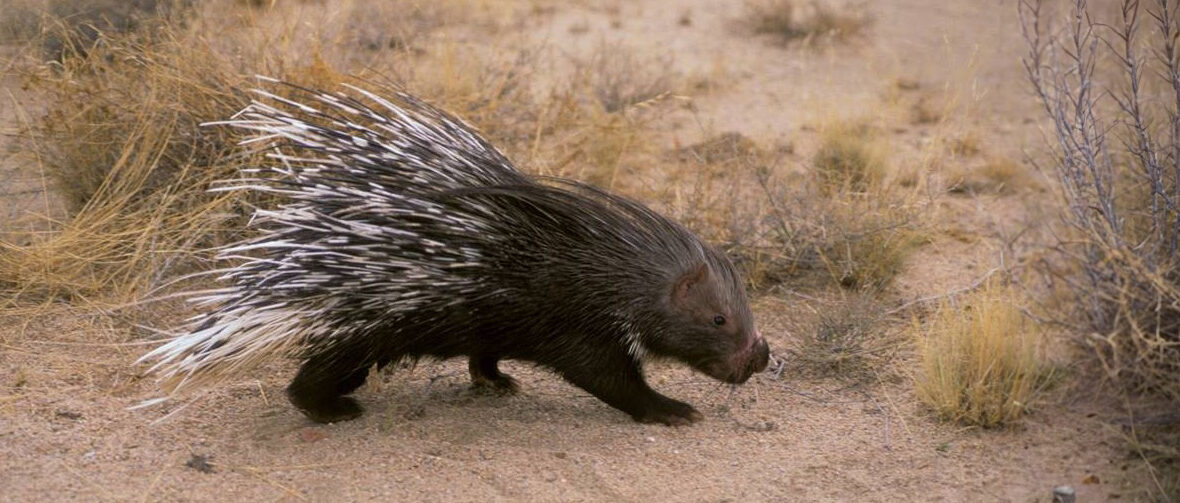
The Indian porcupine, aka Indian crested porcupine, can be found throughout southeast and central Asia, as well as the Middle East. They tolerate a wide range of habitats such as tropical and temperate scrublands, rocky hillsides, grassland habitats, and forest habitats. Due to their abundance and perception of being an agricultural pest, these prickly critters are listed as Least Concern by the IUCN. Their populations are stable.
First the Stats…
Scientific name: Hystrix indica
Weight: Up to 44+ lbs.
Length: Up to 35+ inches, plus up to a 3.94 inch tail
Lifespan: Up to 27 years
Now on to the Facts!
1.) They can be found in Afghanistan, Armenia, Azerbaijan, China, Georgia, India, Iran, Islamic Republic of Iraq, Israel, Jordan, Kazakhstan, Nepal, Pakistan, Saudi Arabia, Sri Lanka, Syrian Arab Republic, Turkmenistan, Türkiye, and Yemen.
2.) These critters can be found at elevations of up to 7,874 feet.
3.) Porcupines are from the rodent family.
4.) The Indian porcupine is among the largest of the porcupine species, with the African crested porcupine being the largest.
5.) Indian porcupines are terrestrial (spend their lives on the ground) and fossorial (spend part of their lives in burrows underground).
But wait, there’s more on the Indian porcupine!
6.) Their quills are up to 16 inches long!
7.) These porcupines, like others, are nocturnal (active at night).
Did you know…?
Seeing as they are rodents, their teeth constantly grow and need to be worn down. To do this they will gnaw on a variety of tough substances such as bark, trees, chain link fences, and even concrete!
8.) It may not look like it, but these critters are actually good swimmers.
9.) During the winter months, they tend to spend more time out of their dens during the day, whereas in summer they are more active at night. This is based on the cycle of surrounding predators.
10.) A group of porcupines is called a prickle.
But wait, there’s still more on the Indian porcupine!
11.) Various fruits, grains, roots, and a variety of vegetable matter are all on the menu.
12.) These porcupines are monogamous (mate for life).
Did you know…?
To aid in calcium enrichment for the growth of their spines, these prickly rodents will chew on old bones. This is called osteophagia.
13.) Females undergo up to a 240 day gestation (pregnancy) that yields up to 4 pups, aka porcupettes.
14.) Porcupettes are born with soft quills (in case you were wondering how mom births a living pin cushion) that harden a few hours after birth.
15.) Pups are weaned at about 19 weeks of age, but remain with their parents for up to 1 year.
But wait, there’s still a little more on the Indian porcupine!
16.) When threatened, they will rattle the hollow quills on their back and tail, which produces a noisy rattling sound. If this fails to get the point across they will turn their back to their attacker and charge.
17.) Their quills are actually modified hair and are made of keratin, like our hair and fingernails. The tips of their larger quills are equipped with backwards facing barbs that can cause substantial pain when stabbed.
Did you know…?
Their quills are covered with a greasy coating. This substance contains antibiotics, which can negate infections in the event that a porcupine is accidentally pricked by their own quills.
18.) The name ‘porcupine‘ hails from the Latin words “porcus”, meaning pig, and “spina”, meaning thorn.
19.) Porcupines can be heard grunting as they search for food.
20.) Tigers, leopards, caracals, wolves, striped hyenas, Asian wild dogs, and saltwater crocodiles all take their chances with preying on these critters.
Now a Short Indian Porcupine Video!
Be sure to share & comment below! Also, check out the Critter Science YouTube channel. Videos added regularly!
Want to suggest a critter for me to write about? Let me know here.
Some source material acquired from: Wikipedia & IUCN
Photo credit: Biology of Animals



